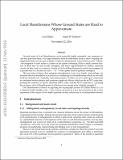| dc.contributor.author | Eldar, Lior | |
| dc.contributor.author | Harrow, Aram W. | |
| dc.date.accessioned | 2020-01-21T16:32:21Z | |
| dc.date.available | 2020-01-21T16:32:21Z | |
| dc.date.issued | 2017-11-13 | |
| dc.date.submitted | 2016-11-21 | |
| dc.identifier.isbn | 978-1-5386-3464-6 | |
| dc.identifier.isbn | 978-1-5386-3465-3 | |
| dc.identifier.issn | 0272-5428 | |
| dc.identifier.uri | https://hdl.handle.net/1721.1/123484 | |
| dc.description.abstract | Ground states of local Hamiltonians can be generally highly entangled: Any quantum circuit that generates them (even approximately) must be sufficiently deep to allow coupling (entanglement) between any pair of qubits. Until now this property was not known to be robust - the marginals of such states to a subset of the qubits containing all but a small constant fraction of them may be only locally entangled, and hence approximable by shallow quantum circuits. In this work we construct a family of 16-local Hamiltonians for which any 1-10[superscript-8] fraction of qubits of any ground state must be highly entangled.This provides evidence that quantum entanglement is not very fragile, and perhaps our intuition about its instability is an artifact of considering local Hamiltonians which are not only local but spatially local. Formally, it provides positive evidence for two wide-open conjectures in condensed-matter physics and quantum complexity theory which are the qLDPC conjecture, positing the existence of good quantum LDPC codes, and the NLTS conjecture due to Freedman and Hastings positing the existence of local Hamiltonians in which any low-energy state is highly-entangled.Our Hamiltonian is based on applying the hypergraph product by Tillich-Zemor to the repetition code with checks from an expander graph. A key tool in our proof is a new lower bound on the vertex expansion of the output of low-depth quantum circuits, which may be of independent interest. Keywords: quantum entanglement; stationary state; robustness; complexity theory; graph theory | en_US |
| dc.description.sponsorship | National Science Foundation (U.S.) (Grant CCF-1111382) | en_US |
| dc.description.sponsorship | National Science Foundation (U.S.) (Grant CCF-1452616) | en_US |
| dc.description.sponsorship | National Science Foundation (U.S.) (Grant CCF-1629809) | en_US |
| dc.description.sponsorship | United States. Army Research Office (Contract W911NF-12-1-0486) | en_US |
| dc.publisher | Institute of Electrical and Electronics Engineers (IEEE) | |
| dc.relation.isversionof | http://dx.doi.org/10.1109/FOCS.2017.46 | en_US |
| dc.rights | Creative Commons Attribution-Noncommercial-Share Alike | en_US |
| dc.rights.uri | http://creativecommons.org/licenses/by-nc-sa/4.0/ | en_US |
| dc.source | arXiv | en_US |
| dc.title | Local Hamiltonians Whose Ground States Are Hard to Approximate | en_US |
| dc.type | Article | en_US |
| dc.identifier.citation | Eldar, Lior, and Aram W. Harrow. “Local Hamiltonians Whose Ground States Are Hard to Approximate.” 2017 IEEE 58th Annual Symposium on Foundations of Computer Science (FOCS), October 2017, Berkeley, California, USA, Institute of Electrical and Electronics Engineers (IEEE), November 2017 | en_US |
| dc.contributor.department | Massachusetts Institute of Technology. Center for Theoretical Physics | en_US |
| dc.relation.journal | 2017 IEEE 58th Annual Symposium on Foundations of Computer Science (FOCS) | en_US |
| dc.eprint.version | Original manuscript | en_US |
| dc.type.uri | http://purl.org/eprint/type/ConferencePaper | en_US |
| eprint.status | http://purl.org/eprint/status/NonPeerReviewed | en_US |
| dc.date.updated | 2019-03-26T15:29:31Z | |
| dspace.orderedauthors | Eldar, Lior; Harrow, Aram W. | en_US |
| dspace.embargo.terms | N | en_US |
| dspace.date.submission | 2019-04-04T11:19:12Z | |
| mit.license | OPEN_ACCESS_POLICY | en_US |
| mit.metadata.status | Complete | |
